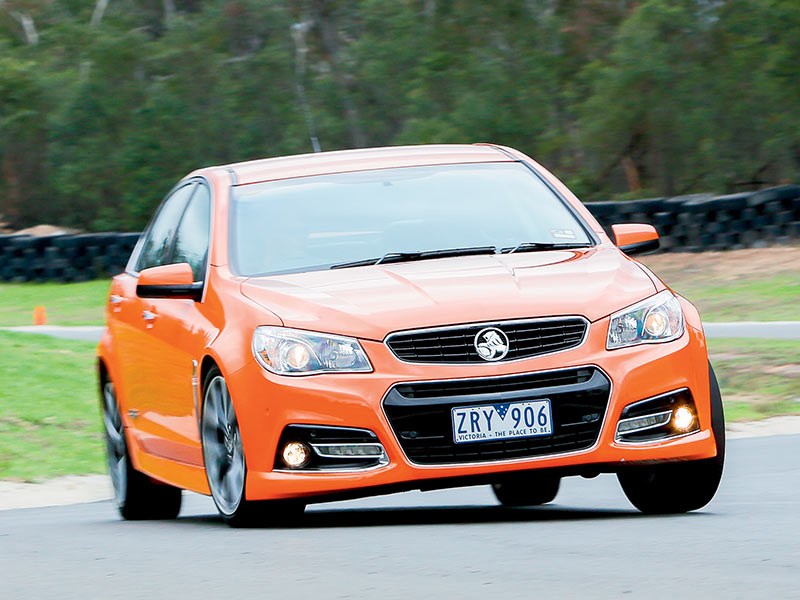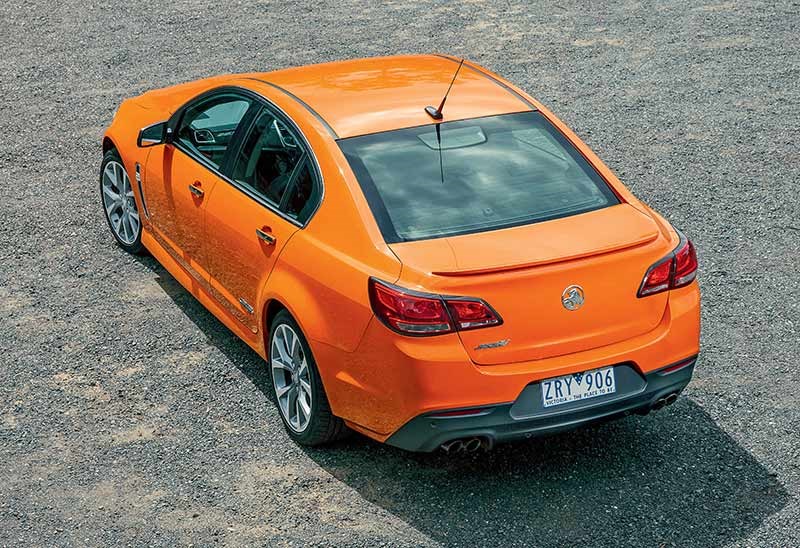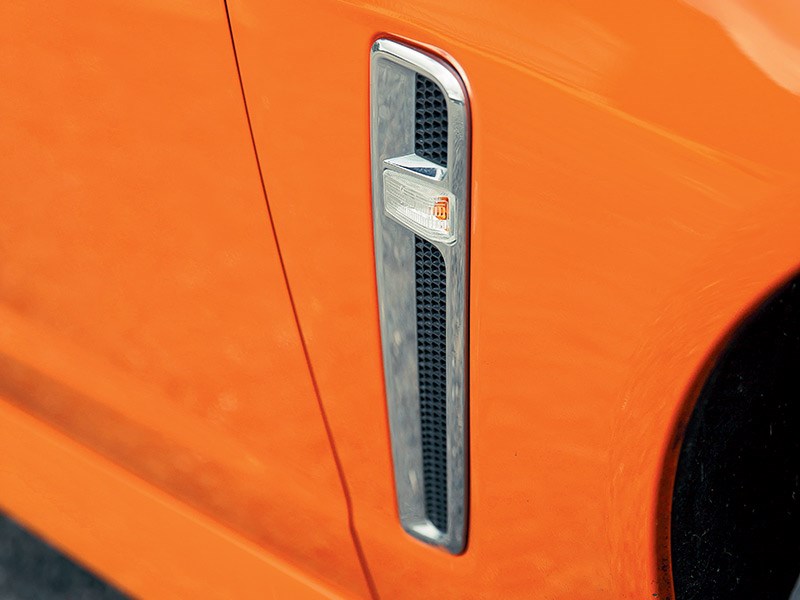VF Commodore SS-V: Top ten Holdens #9
 Top ten Holdens: VF Commodore SS-V
Top ten Holdens: VF Commodore SS-V

 Top ten Holdens: VF Commodore SS-V
Top ten Holdens: VF Commodore SS-V

 Top ten Holdens: VF Commodore SS-V
Top ten Holdens: VF Commodore SS-V

 Top ten Holdens: VF Commodore SS-V
Top ten Holdens: VF Commodore SS-V

 Top ten Holdens: VF Commodore SS-V
Top ten Holdens: VF Commodore SS-V

 Top ten Holdens: VF Commodore SS-V
Top ten Holdens: VF Commodore SS-V


|
|
Top ten Holdens: VF Commodore SS-V
|

|
|
Top ten Holdens: VF Commodore SS-V
|

|
|
Top ten Holdens: VF Commodore SS-V
|

|
|
Top ten Holdens: VF Commodore SS-V
|

|
|
Top ten Holdens: VF Commodore SS-V
|

|
|
Top ten Holdens: VF Commodore SS-V
|
VF: Commodore's acclaimed last hurrah...

|
|
Top ten Holdens: VF Commodore SS-V
|
VF Commodore SS-V
 |
> Watch the video here |
It is fitting that the last of the locally engineered and built Commodores are also the best. Sure, there could be a facelift between now and when Holden finally turns off the taps, but the basic VF as you see it now is the last of them. And it’s also as good as it ever got.
Maybe that was part of the problem; as Holden has taken the wraps off each successive all-new Commodore model (and there have been three of them if you accept that the VF is a facelift of the VE) the concept has been smoothed and refined to the point where the VF is a genuine world-beater. But it’s taken 36 years to get there.
That said, nothing can diminish the polish with which the VF SS-V handles anything and everything thrown at it. The VF body is big and strong, the handling is now good enough to give the big-dollar Europeans a big fright and so are the refinement and levels of NVH.
And then there’s that six-litre Chev-sourced engine that kicks out 270kW of power and no less than 530Nm of torque with a feeling that it could easily be tuned to produce more. Much more.
As it is, the six-speed manual is made more or less redundant by all those Newton-metres; the better-than-it’s-ever-been six-speed automatic is now the gearbox of choice.
Point the VF SS-V up a freeway and it will destroy big distance, five-up and towing a boat if you like. Unhitch the tinny and head for the twisties and the SS-V shows just how agile a big car can be. And all the while everybody inside has enough room and remains comfortable. To get anything like these levels of sophistication and outright ability, you need to be shopping for a full-sized Euro sedan from the likes of AMG or BMW with a full-sized Euro price tag to match.
And, unlike a lot of big, heavy cars, the SS-V is actually great fun to drive. The V in SS-V gets you a few extra trim pieces, but such as leather seats, and you can opt for the Redline package with its bigger brakes and boofier rear spoiler if that’s your thing. But they all get the refinements that the VF has brought along with a 40kg weight cut over the VE model thanks to touches like an aluminium bootlid and bonnet.
The downfall of Holden as a manufacturer in this country has nothing to do with the VF Commodore. Indeed, in SS-V form, it’s among the best big road cars you can buy at any price. But therein lies the rub: It’s a big car, and that’s just not what buyers are looking for these days. What a crying shame, for we shall never see its like again. The VF SS-V is another one of those cars that will make us realise what we’re losing when local manufacturing bites the dust.
Putting sentimentality to one side, even if Holden had been looking forward to another six decades of making cars here, the current SS-V would still stand tall among its peers from anywhere else in the world.
JOHN WRIGHT'S INSIDE WORD:
The first Holden badged as SS came in September 1972, a limited-edition HQ based on the Belmont with 253 V8 engine, four-on-the-floor and more. Its role was to prepare the way for the Monaro GTS sedan.
In 1976 there was the Torana SS Hatchback and the badge returned to full-size Holdens in 1982 to adorn a car that was essentially the same proposition as the 1972 SS, albeit not a limited edition. It was this VH SS that gave the HDT operation its starting point for Group One, Group Two and Group Three hot Commodores. Then, with VK, the SS was an HDT rather than a Holden.
The VN was launched in August 1988 with no V8 engine option, but seven months later the first injected 5.0-litre unit was introduced. This was when the Commodore SS became a regular Holden production model: five-speed manual, 15x6 alloys, FE2 suspension, spoilers and stripery.
At the launch of the VT I noted the 17-inch alloys and asked chief engineer Tony Hyde how he had convinced management to fit such big wheels as standard. "I just told them it had to have 17s," he said. It was a measure of the importance of the SS in the Commodore line-up. This attention to the sports model somehow validated the integrity of the entire VT range. Remember this was the Holden that sealed the Commodore’s sales dominance over its rival – from 1997 to now and doubtless forever.
As for the ‘V’, that did not arrive until August 2006 with VE. The SS-V added more luxury and a more overtly sporting image with standard 19-inch alloys. As for the SS, it essentially replaced the outgoing SV8 as the entry level Commodore V8.
There was a Calais-V as well, while the Calais stepped down to supersede the old VZ Berlina. The same trick would be used in 2010 when the Statesman was renamed Caprice, leaving the former Caprice spec to a car called Caprice-V.
In 2013, the VF brought more subtlety to the SS-V, although at the time no-one seemed to imagine this would be the last of its kind.
Don’t you get sick of those reviews that cry "Best Commodore Ever", as if it’s somehow surprising that the new car the engineers have worked on should be better than the previous one? While the VF SS-V is undoubtedly the best SS ever – how could it not be? – I don’t think that, as a product of its era, it is as impressive as either the VN was in February 1989, or the VT in September 1997.
The VT was underpowered for its near-1700kg with just 179kW, but it was beautiful. The real trump was its Series II successor with 220kW from a detuned 5.7-litre Chevrolet engine weighing 80kg less and running through a six-speed manual. In June 1999 you needed an HSV to do much better.
THE MARKET TREND
Long-term value relies on scarcity and condition and there is little chance of the SS-V becoming a rarity during the lifetime of its original owners.
Even if this turns out to be the last Australian-built SS, there is little reason to house, maintain and insure one for 30-40 years in the hope it might become collectable. These cars are being built in such numbers that you won’t be the only person with the same ambition of gaining future wealth.
Remember also that during decades to come social influences could dramatically reduce the number of people who want a throwback to the age of ‘fossil fuels’. Sorry, kids, the SS-V really needs to be labelled ‘enjoy now’.
SPECIFICATIONS
VF Commodore SS-V
Production: 2013-present
Body: 4-door sedan/wagon
Engine: 5967cc V8, OHV, 16v
Power: 270kW @ 5600rpm (man)
Torque: 530Nm @ 4400rpm (man)
0-100km/h: 5.5sec (claimed)
400m: n/a
Gearbox: 6-auto/6-man
Suspension: MacPherson struts (f); Independent, trailing arms, coils (r)
Brakes: Discs
*****
More reviews:
Unique Cars magazine Value Guides
Sell your car for free right here
Get your monthly fix of news, reviews and stories on the greatest cars and minds in the automotive world.
Subscribe

.jpg)






.jpg)



.png)



